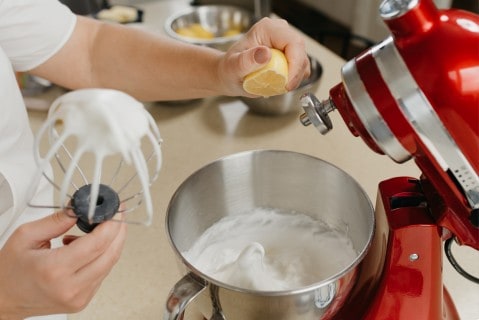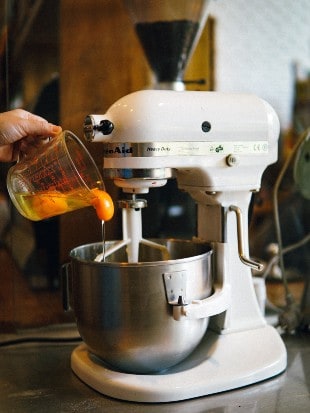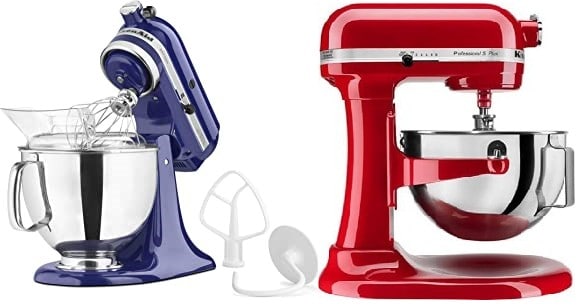If you’re in the market for a stand mixer, you may wonder if a bowl lift stand mixer vs tilt head mixer is better for you. Both types have their pros and cons, so let’s inspect each one. A tilt head mixer has the top portion attached to the motor with a hinge, allowing you to tilt it back and get access to the bowl. A bowl lift mixer has a lever that raises the bowl up off the base and into the mixing position. So, which is better? Let’s find out.
Table of Contents
What is a Bowl Lift Stand Mixer?
A bowl lift stand mixer has a mechanism that raises and lowers the bowl above the base for adding ingredients or removing the bowl. This type of mixer is often preferred because it is more stable and has a stronger motor than tilt head mixers. It’s a good choice if you want a stand mixer for bread dough or for making heavier batches of anything. These types of mixers also tend to come with a larger bowl capacity and have a large footprint overall. Avid bread bakers even prefer these stand mixers to bread machines because of the control they can have over different types of dough.
What is a Tilt Head Stand Mixer?
A tilt head stand mixer has a mechanism that allows the head to be tilted away from the bowl that’s always on the base so that you can add ingredients or remove the bowl more easily. This mixer is often preferred because it takes up less space and has a lighter weight than bowl lift mixers. It’s also less expensive than bowl-lift types.
What is the Difference Between Bowl Lift and Tilt Head Mixers?
The key differences are in how they function while mixing, how much storage space they require, their ease of use, and their overall strength. Bowl lift mixers are more stable and have a stronger motor than tilt head mixers. They use a mechanism to lift the bowl up to reach the beaters. Tilt head mixers take up less space and weigh less than bowl lift mixers, but tilt head mixers can be less sturdy when mixing heavier ingredients. The head swings down into the bowl to mix the ingredients.
Which one is better? The answer to this question depends on your needs and preferences. If you are looking for a mixer that can handle regular use while mixing heavier batches of ingredients, then bowl lift mixers have a powerful motor and are therefore a better option. If you are looking for a mixer that you will use only occasionally or only for lightweight mixing tasks, then the lighter, smaller, and less expensive tilt head mixers are the better option.
Pros and Cons of Kitchenaid Tilt Head Vs Bowl Lift Stand Mixers
Bowl lift stand mixers and tilt head stand mixers are both great options for your kitchen. It is all about what your mixing needs are, your budget, and how much storage space you have available to you. Be sure to check out the full line of KitchenAid models and other appliances from other brands such as Cuisinart, Kenmore, Hamilton, and Hobart to find the perfect one for your needs.
Pros of Bowl Lift Stand Mixers
Cons of Bowl Lift Stand Mixers
Pros of Tilt Head Stand Mixers
Cons of Tilt Head Stand Mixers
KitchenAid Tilt-Head Models
If bread dough kneading is not your main concern, one of the tilt-head models will do just great for you. In addition to the specifications of each listed below, we explain the differences between the KitchenAid Classic, Classic Plus, and Artisan models in-depth for you as well as review the Artisan Mini Mixer.

Classic
The Classic Stand mixer is the simplest of all the KitchenAid mixers and is the least expensive. It also uses the lowest powered motor.
Classic Plus
This KitchenAid Classic Plus just comes with a slightly more powerful motor than the Classic.
Artisan
The KitchenAid Artisan Stand Mixer is the highest powered and has the largest bowl capacity of all the tilt head models.
Artisan Mini
The Artisan Mini Stand mixer is the smallest KitchenAid model but with all the features of the full size Artisan. Its motor power is also lower.
KitchenAid Bowl-Lift Models
Professional 600
 The Professional 600 stand mixer is the lowest powered of all the bowl lift models but higher than any of the tilt head models and is great for home bakers who need to do some heavy mixing.
The Professional 600 stand mixer is the lowest powered of all the bowl lift models but higher than any of the tilt head models and is great for home bakers who need to do some heavy mixing.
Professional 6500 Design Series
This Professional 6500 Design Series stand mixer is a pro version of the Professional 600, as it has a higher powered motor, which is good for more regular use.
Pro Line
The Pro Line stand mixer is perfect for heavy-duty and large batch mixing with its larger bowl and highest powered motor.
Conclusion: Is a Bowl Lift or Tilt Head Mixer Better?
This depends on the job you’re taking on. If it’s baking at home just for your family, you’re going to be fine with something that’s smaller. If you’re whipping up things like cake and other batters, or lighter things like meringues or whipped cream, you’ll want to look at a tilt head mixer.
Those who are feeding large groups or making bread or shaped cookies regularly will find that the larger-sized bowl lift ones are better, as they have more power and capacity.
The difference between a bowl lift stand mixer and tilt head stand mixer is straightforward. A bowl lift has the mixing arm attached to a stationary head and the bowl is lifted to reach it, while a tilt head works by lifting and lowering its head on a hinge point to move down or away from the stationary bowl below. Both types have their pros and cons based on what your kitchen needs may be. If you’re not sure which one will work for you, it’s worth spending the time researching to get a mixer of excellent quality and durability.

